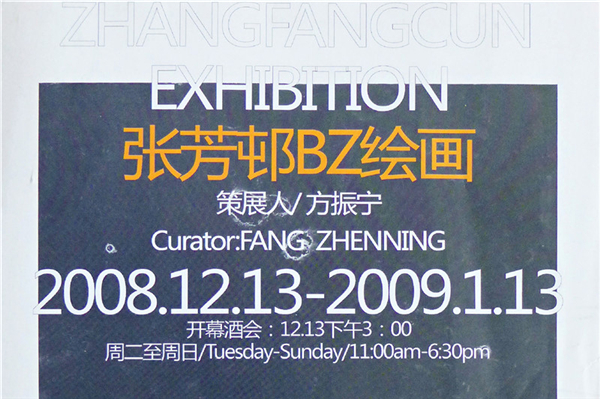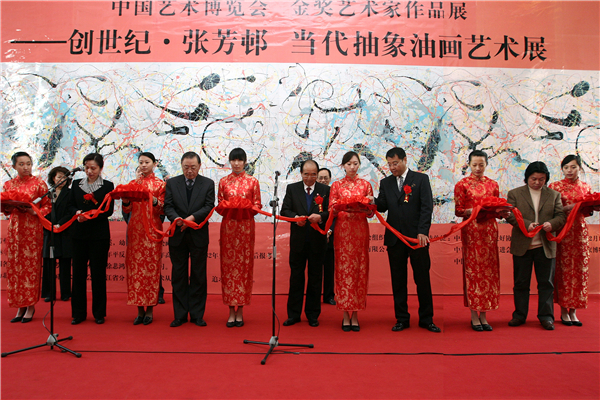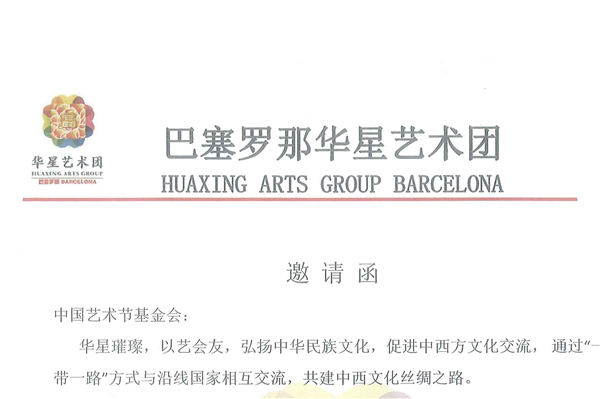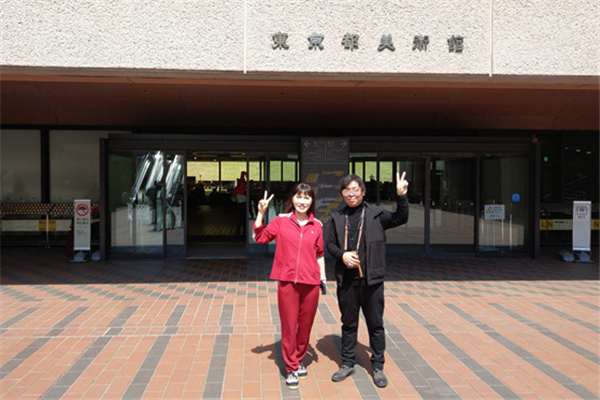2008In "Zhang Fangcun BZ Art Exhibition" on display in FANGART / curator / Fang Zhenning(Internationally renowned art critic authority)

2008In works in Germany、France、Austria roving exhibition
2018On August 29
2009To participate in the 2009 Chinese Abstract Art Exhibition "to return to the modern" West Lake in Zhejiang Art Museum·Hangzhou
2018On August 29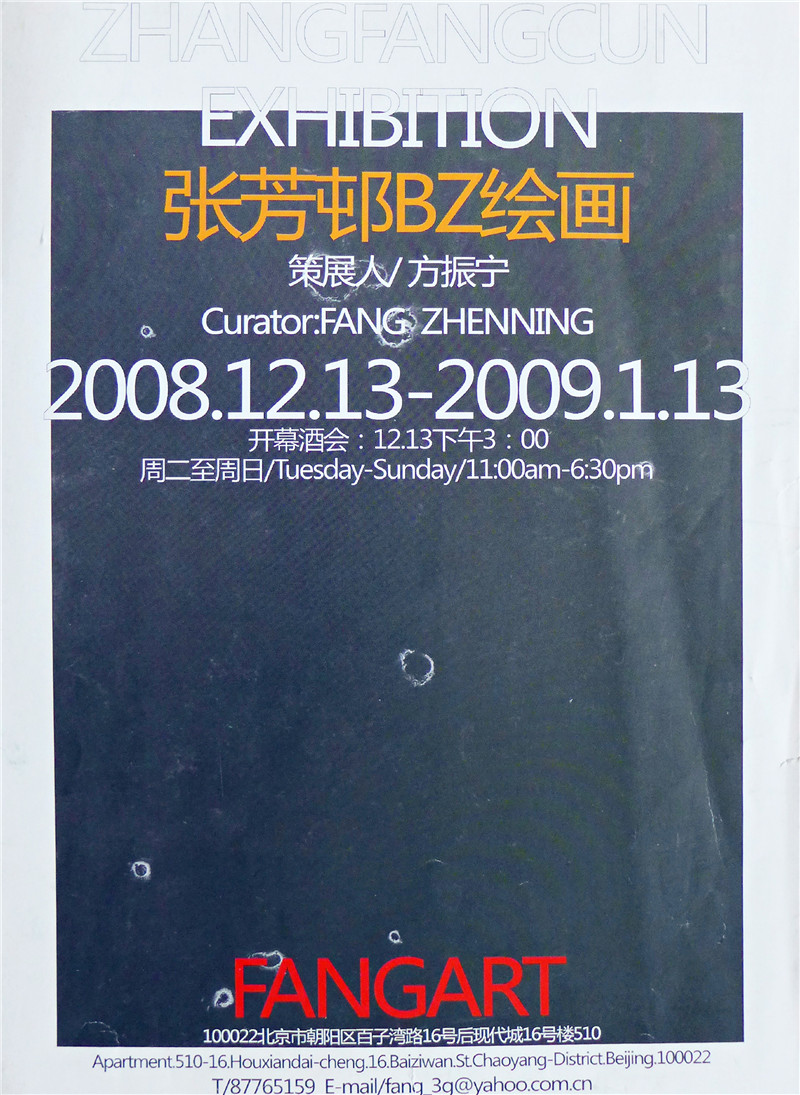
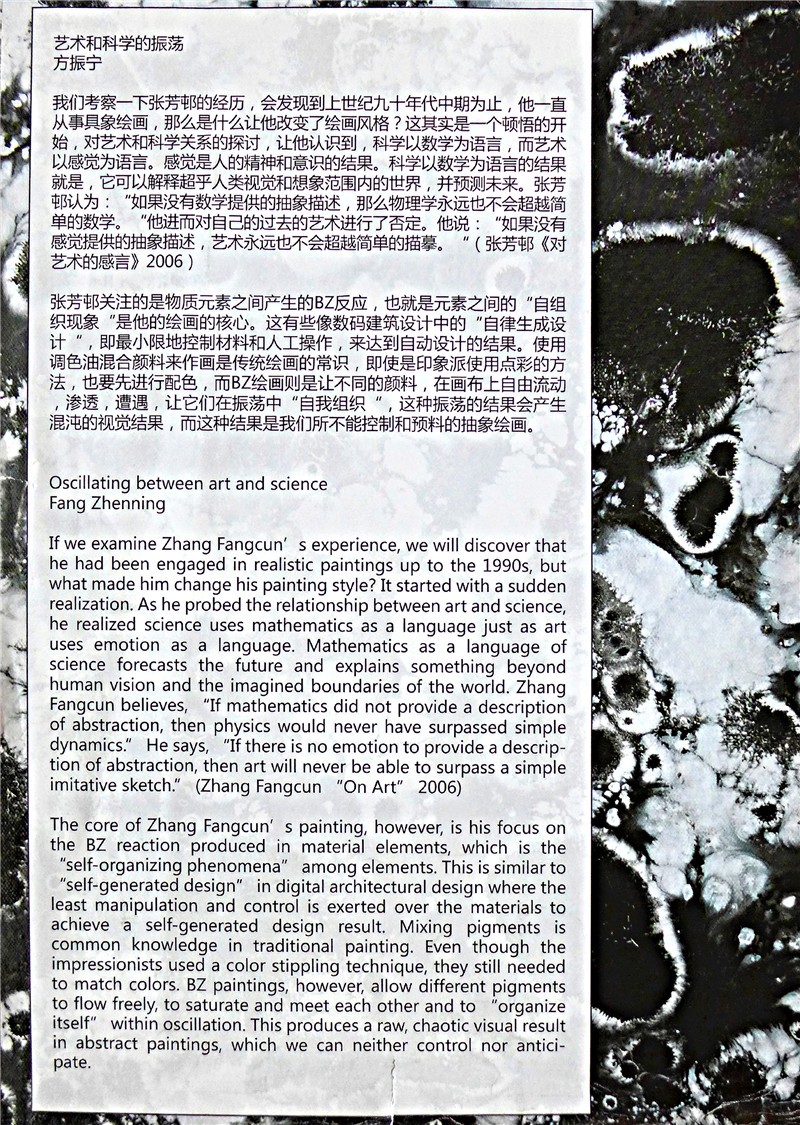
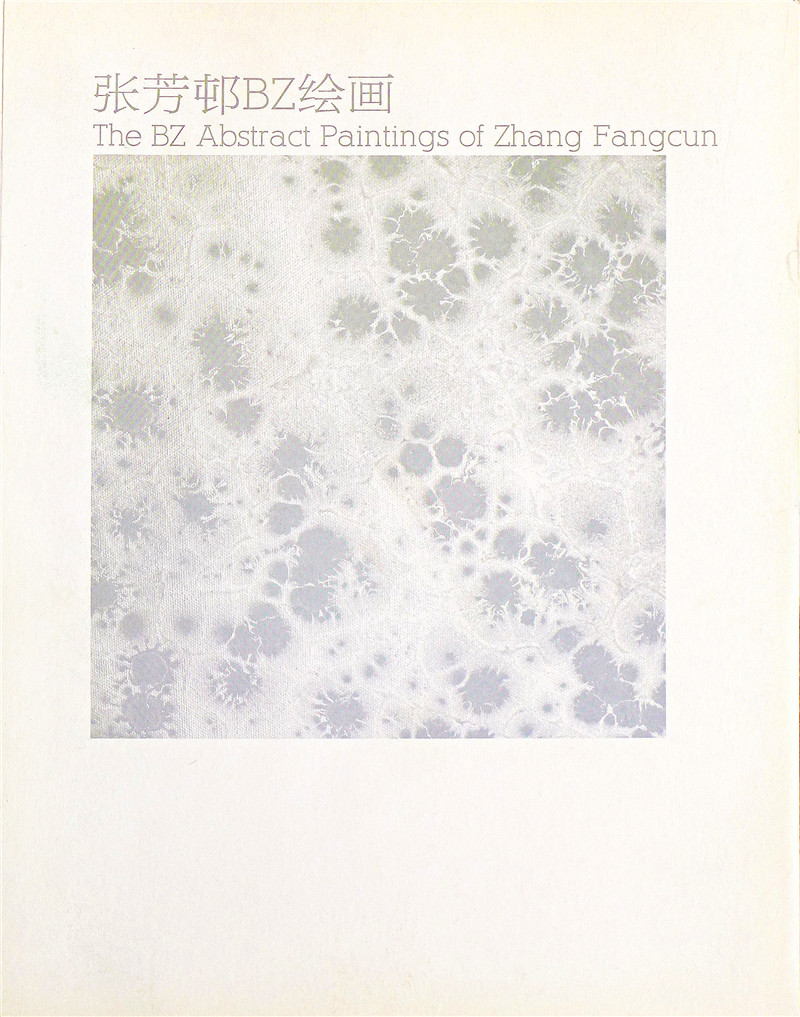

2008In the internationally renowned art critic Fang Zhenning:"Zhang Fangcun" BZ Art "inventions subvert the history of art,Beyond the previous artist's contribution to art history!”
Oscillation of art and science
- Zhang Fangcun unique·BZ Art
Culture/Fang Zhenning (internationally renowned authority art critic)
BZ Art advent
The term "abstract art" is the vocabulary of modern art in the 20th century appears,But as a way of thinking,"Abstract" thinking already in the early development of human society,Especially those ancient civilizations,If there is no abstract thinking ability,Civilization does not progress to this day。Abstract high-end form of human thinking,It is the figurative things refined after,Be conveyed symbolic,Displayed as text and visual arts in terms of,and so,"Abstract art" originated in the 20th century became an independent category of art,It is the inevitable result of the development of human civilization。
In addition to Chinese hieroglyphs,There are a lot of abstract expressionism in the ancient art,In addition to the artificial drawing pattern,But also to create a new aesthetic standard through accidental discovery。E.g,Let the glaze color temperature by natural,And a method of making ice cracks,Is the art and science of oscillations resulting out of the masterpieces of art。Why refer in particular to the case of ancient Chinese art and science of art? Because the topic of this article is about the art and science of oscillation,This is a brief summary of the comb art and science of historical relations and choroid,In order to explain the relationship between the statement and the historical context of。
Artist Zhang FangcunBZ Art is a new topic of today's Chinese art circles appear,Therefore BZ Art triggered a series of discussion and concern。About "BZ Art" So we have to do something this simple "literacy",First "BZ" What is?
The phenomenon of self-organization
"BZ" is chemistry "Belousov- Zhabotinskii reaction "is abbreviated。We need the time to play back a half-century before 1958,Former Soviet chemist Belousov(Be-lousov,B.P.1893~1970) First discovered "chemical oscillations" in a single experiment,His form is displayed as "self-organizing phenomenon",But did not acknowledge the scientific community,after that,Biologists Zhabao Ting Siji (A. M. Zhabotinskii) once again confirmed this phenomenon,Ie, molecules that participate in the reaction,After receiving the macro as if some kind of unified command organize themselves,Acting on a space and time。The so-called "self-organizing phenomenon" refers to an ordered macroscopic phenomena in nature spontaneously formed。In the nature of this phenomenon abound,Scientists believe that,This phenomenon penetrated into every corner of the universe and every moment。
is called"BZ reaction" and "self-organizing phenomenon" is a theory in the scientific world,It is the science of chemical processes of evolution,Since the fifties has been widely used in chemical sciences,BZ reaction unexpected phenomenon display。Suppose we have two chemical solutions,One is the "amber",One is the "blue"。Because of the confusion after mixing motion of molecules,We can imagine that at a given moment there are more "Amber" is located in a region of the container,after a while,There will be more "blue" gathered。such,We observed that the solution presented as "black or gray.",There may be occasional and irregular flash "amber" or "blue"。but,But in fact, it's not,it's here,The system starts completely colorless,Then it suddenly changed to amber color,Then change to colorless(Quite short),And quickly changed to blue,Color of the solution will oscillate between blue and amber,And all these changes are to take place at regular intervals,Automatically maintains a constant cycle change。They are automatically generated very beautiful、Periodically changing pattern,Like a pendulum of time for regular oscillation,These seem to "organization" of the phenomenon is entirely generated by the internal reasons,And not a foreign designer or operator。This phenomenon is called "chemical oscillations" or "chemical clock" in the experiment。
The phenomenon of self-organization
This finding raises the classical thermodynamic theory questioned。1969year,Until the founder of modern dynamics,Belgium famous scientist Nobel Prize winner Ilya Prigogine • ((Ilya Prigogine)) Put forward the theory of dissipative structures,The reason it was a clear understanding of the oscillating reaction,This theory is the study of the mechanisms and laws of transformation from chaos to order,This book has explained, "From chaos to order" The basic idea in。Since then,,Oscillating won the attention,Its research has been developing rapidly。However, to the seventies,Chemists and chemical phenomena in succession proved chaotic oscillations exist,And gradually formed a chemical chaos theory、It can be said,Chemical oscillation is turned on chaos theory of a key chemical。Nearly 20 years,Chemical reaction of self-organization,It has become a very fashionable subject。
However, the phenomenon of self-organization paradigm is just a small example of what we,Self-organization and the law is the law of entropy increase law of one of two equally important,A dead about the universe,A student about the universe。And this phenomenon of self-organization law inspired by the artist's understanding of painting methodology and development of new areas of,Zhang FangcunThis principle is derived from the BZ Art。
science:Venus Art
We look at the experience of Zhang Fangcun,You will find that until the mid-1990s,He has been engaged in figurative painting,So what made him change his style of painting? In fact, this is the beginning of a epiphany,Discussion on the relationship between art and science,Let him know,Science to mathematics as the language,And the feeling is the language of art。Feeling is the result of the human spirit and consciousness。Mathematics is the language of science to result,It can be interpreted beyond human vision and imagination within the scope of the world,And predict the future。Zhang Fangcun think:"If there is no mechanical abstract description provided,Then physics will never go beyond the simple math。"He then carried her past negative artistic。He said:"If you do not feel abstract description provided,Art will never go beyond simple tracing。"(Zhang Fangcun" reflections on art, "2006)
Let's just look at the history of art since the nineteenth century, you will find,Modern Paintings,If there is no scientific revelation,May never tune in soy sauce yard crawl。Scientific discovery is light,Let impressionist open up horizons,And the true light into the painting。
Art of the claimed invention
Was Marcel• Duchamp (Marcel Duchamp,1887-1968) first teacher of mysticism Czech avant-garde painter 弗朗蒂塞克 • Kupka (Frantisek Kupka 1871-1957), 1895Year went to settle in Paris,His interest in medieval mysticism and the origin of the universe,And indulging in Newton's theory of science,Created a direct depicting Newtonian theory and logic works。Kupka said:"As the reality itself is an abstract work of art,The components themselves of the invented composition。Its meaning comes from the prototype morphology (morphological archetypes) in combination with suitable building in the form of its inherent function (architectonic conditions) a。"Kupka's abstract works of art were evaluated as a manifestation of the strange life。Examples cited here is to show Kupka,Art is to show "another reality",Great art is the connotation of the people as a part of the universe is always in the pursuit of unlimited,With that spirit of creation science,It is the basic attitude of the artist,BZ Art Zhang Fangcun is the marriage of art history of art and science continue,Also said Kupka,Art Positive required by the components of the invented compositions。
On the surface,Zhang FangcunBZ Art seems similar to American abstract painter Jackson Pollock •(Jackson Pollock,l912–1956)style of,But in essence it is different。Pollock contribution to the history of painting is to liberate painting of gravity。He is the first time the pen drawing of freedom to paint without touching the canvas。And Zhang Fangcun concern that the BZ reaction between the material elements of the,That is "self-organizing phenomenon" among the core elements of his paintings。This is somewhat like digital architectural design "self-generation design.",I.e., the minimum and manual control materials,To achieve the results of the automatic design。Use oil pigments mixed palette to paint a painting traditional knowledge,Even impressionist method using stippling,Also first color matching,The BZ Art is to let different pigments,Free flow on the canvas,penetration,encounter,Let them in the oscillation "self-organization",This result would be chaotic oscillations visual results,And this result is that we can not control and predict BZ Art。
That is the life of self-organization
We canThe process of "self-organization" is understood as "life" of。After the artificial tissue is a process of experience,He will become our memories,We strengthen certain parts,And it is recorded as a logic,This self-made system approach,Serve allows us to inertia in the concept of,Not easy to accept those "self-generated drawing.",That is, it would be "self-organizing phenomenon" to be inconsistent,Even in the Belousov–Before Zhabao Tingsi Ji's "BZ reaction" recognized,Scientists are on the "phenomenon of self-organization," scoffed。In fact, both traditional and color palette,Or BZ Art,They are from a different perspective,The use of pigment chemistry to achieve the purpose of performance and aesthetic judgment,BZ difference between traditional painting and art is,The former can be directly controlled stop where,While the latter is subjected to a pigment limited,Continue to observe the natural reaction of process,And it is always the result of more than chaos and beauty than we thought,Because of this self-organization phenomenon is part of the natural movement of the universe,Humanity is the discovery and use it only。
Since the phenomenon of self-organization is part of the natural movement of the universe,The creation of art is not beyond painting,The artist might be involved in an eternal universe in motion otherwise go,This is what we expect near-future。
Zhang FangcunBZ Art,Chinese painting is rare in the art world exists in the current,He likened the practice of art and science of oscillation,I thought it was very appropriate。
BZ creation of art is revolutionary milestone in the history of world art,It changed the course of art history,From ancient times to subvert the history of art and various art schools,Beyond Picasso、Contribution Pollock and other artists of the past, the world of art history art history。
After Fang Zhenning in New Town
2008.8.14
Fang Zhenning Internationally renowned art critic authority,Independent curator,artist
From1988He began writing abstract、Minimalism and conceptual art works,So far 2000 has been engaged in artistic creation and criticism in Tokyo,Now lives in Beijing。1996Years has been millions of words written art criticism,At present modern art、Based planning and architectural review。It is one of China's most senior contemporary modern art critic. Blog writer,Its sharp writing and insight has won a wide readership。
Oscillating between art and science
—The unique BZ ART of Zhang Fangcun
Author Fang Zhenning(The famous international authoritative art critic)
The Emergence of BZ ART
The term “abstract art” only emerged in 20th century modern art vocabulary. “Abstract” thinking, however, has long been in the development of human society, particularly in ancient civilizations. Civilization would not have advanced to this day if not for abstract thinking. Abstraction is civilization’s elevated form of thinking. Text and art are revealed from a visual perspective by abstracting the definite and conveying the symbolic. Therefore, “abstract art” originated in the 20th century and became an independent category of art. It is the inevitable result of humanity’s evolution.
In China, apart from the image based pictographs, there was prolific abstract expression in ancient art aside from man-made painted patterns. Through accidental discoveries, a new art standard was established. For example, the production method of using high temperatures to allow glaze to naturally change color and the process leading to ice cracks are the result of the oscillation between art and science that produced works of art that have continued through generations. Why this special reference to science and art in ancient Chinese art? As the subject of this essay is on the oscillation between art and science, this simple summary of the historical relationship of art and science illuminates the cultural pulse and relationship of this topic to history.
Artist Zhang Fangcun’s BZ ART has presented a new theme in China’s contemporary art world. BZ ART have triggered a series of discussions and attention. We must do some simple ‘educating’ regarding “BZ ART” , firstly, what is “BZ”?
Self-Organizing Phenomena
“BZ” is short for the “Belousov-Zhabotinskii reaction” in chemistry. We need to go back half a century in time to 1958, when the chemist B.P. Belousov (1893-1970) of the former Soviet Union first discovered “chemical oscillation” during an experiment, which displayed “self-organizing phenomena.” At the time, however, it was not recognized by the science community. Thereafter, biologist A.M. Zhabotinskii substantiated this phenomenon: namely, from a broad perspective, the molecules organized themselves into a unanimous operation in space and time as if in response to a certain unifying command.
So-called “self-organizing phenomenon” indicates that there is a spontaneous formation of macrocosmic ordered phenomena, which exists on a large scale in the natural world. Scientists believe that this kind of phenomenon pervades every corner and all times of the universe.“Self-organizing phenomenon” also known as a “BZ reaction” is a theory in science; it concerns the science of progression in a chemical process. Since the 1950s, it has been widely used in the study of chemistry; the BZ reaction has surpassed expectations in the phenomena that have been revealed. Suppose we have two kinds of chemical solutions: one is “amber colored” and the other is “blue.” As a result of mixing the two solutions, the molecules are jumbled together. We can imagine at a given moment, there are more “amber colored” areas in the container and after a while, there will be more “blue.” We observe that this solution shows “black or grey” and will randomly turn “amber colored” or “blue.” However, in reality, this is not the case. Here, the system begins to become colorless. It then suddenly changes to amber and then becomes colorless (only briefly) before quickly turning blue. The solution’s colors oscillate between amber and blue at set times and alternating intervals. The changes are self-maintained in set periods and cycles. They will automatically produce beautiful, changing cyclical patterns like a pendulum that formulaically swings back and forth in time. This is like the “organization” of phenomenon which is produced as a result of internal causes. There are no external designs or manipulations at work. During experimentation, this phenomenon is called “chemical oscillation” or “chemical clock.”
Self-Organizing Phenomena
The results of this research have led to the questioning of accepted thermodynamic theory. It was not until 1969 that modern kinetics founder and Belgian Nobel Prize Winner in Chemistry Ilya Prigogine, put forward dissipative structure theory that people clearly recognized the cause of oscillation reaction. This theory investigates the mechanisms and formulas that describe the transformation from chaos to order. This fundamental ideology is expounded in his book “Order out of Chaos.” Since then, oscillation reactions have won recognition and this research has developed rapidly. In the 1970s, chemists proved the phenomenon of chaos within chemical oscillation and gradually formed chemical chaos theory; it could be said that chemical oscillation was the key that unlocked chemical chaos theory. In the past twenty years, self-organizing chemical reaction research has already become a popular field of study.
However, the example that was raised is only an example of self-organizing phenomenon. Self-organization and entropy are equally important theories as one relates to the life of the universe and the other concerns the death of the universe. Self-organizing phenomenon has provided a basis for a new understanding of painting technique theories as well as the development of a new horizon for artists. Zhang Fangcun’s BZ ART principles are rooted in this.
Science: The Light of Art
If we examine Zhang Fangcun’s experience, we will discover that he had been engaged in realistic paintings up to the 1990s, but what made him change his painting style? It started with a sudden realization. As he probed the relationship between art and science, he realized science uses mathematics as a language just as art uses emotion as a language. Mathematics as a language of science forecasts the future and explains something beyond human vision and the imagined boundaries of the world. Zhang Fangcun believes, “If mechanics did not provide a description of abstraction, then physics would never have surpassed simple dynamics.” He says, “If there is no emotion to provide a description of abstraction, then art will never be able to surpass a simple imitative sketch.” (Zhang Fangcun "On Art" 2006)
When we go back to 19th century art history, we discover that if modern painting did not have science as its inspiration, perhaps painting might have been forever stagnant. It was through the scientific discovery of light that Impressionism broke through the visual world and brought true light into painting.
Art Demands Invention
Frantisek Kupka (1871-1957), the Czech avant-garde artist who was Marcel Duchamp’s (1887-1968) mysticism teacher settled in Paris in 1895. He was very interested in medieval mysticism, the origin of the universe and was also engrossed in Newton’s scientific theories. He created a work directly depicting Newton’s theories and logic. Kupka once said, “An artistic work of abstract reality is being oneself; it is made up of the components of what you require yourself to invent. Its meaning comes from the integration of morphological archetypes and architectonic conditions.” Kupka’s abstract art work has been evaluated as expressing the peculiar side of life. Kupka exemplifies how art expresses “another kind of reality.” The grand meaning within art is that man is a part of the universe and always pursue the infinite. The artist’s fundamental demeanor is to create amidst this scientific spirit. Zhang Fangcun’s BZ ART is the sustained relationship between art and science throughout art history. Kupka also said that art required evidence composed of discovered elements.
On the surface, Zhang Fangcun’s ARTs resemble the style of the American abstract expressionist painter Jackson Pollock (1912-1956), but they are essentially different. Pollock’s contribution to art history was the release of gravity in painting. He was the first to paint freely without having the brush come in contact with the canvas. The core of Zhang Fangcun’s painting, however, is his focus on the BZ reaction produced in material elements, which is the “self-organizing phenomena” among elements. This is similar to “self-generated design” in digital architectural design where the least manipulation and control is exerted over the materials to achieve a self-generated design result. Mixing pigments is common knowledge in traditional painting. Even though the impressionists used a color stippling technique, they still needed to match colors. BZ ART, however, allow different pigments to flow freely, to saturate and meet each other and to “organize itself” within oscillation. This produces a raw, chaotic visual result in abstract paintings, which we can neither control nor anticipate.
Self-Organizing Life
We can understand the process of “self-organizing” as “life.” To go through a process of artificial organization where we logically record our memories by highlighting certain parts of it is an experiential process. Turning this into a system makes us enter into conceptual inertia, so it is difficult to accept “self-generated painting” and “self-organizing phenomena.” Before Belousov-Zhabotinskii’s “BZ reaction” was accepted, scientists turned up their noses at “self-organizing phenomena.” Regardless of whether it is BZ ART or the traditional mixing and matching of colors, they both utilize the chemical properties of color through different angles to achieve expression and communicate an aesthetic purpose. The difference between traditional painting and BZ ART lies in the fact that in the former, it is possible to directly control where it ends while the latter uses finite colors to continue to observe the process of natural reactions and its end result will always surpass our imaginings of chaos and beauty. As people have discovered that this self-organizing phenomenon is only a part of the natural movement of the universe, they are now utilizing this information.
Therefore, as self-organizing phenomena is a part of the natural movement of the universe, then the creation of art does not end with painting. Artists will perhaps find other ways to engage in the eternal movement of the universe; this is what we hope for the near future.
Currently, Zhang Fangcun’s BZ ART are an unusual presence in the Chinese abstract painting art world. I think it is most appropriate to liken his practice to the oscillation between art and science.
BZ ART founded is art in the history of the world revolutionary milestone, changed the course of art history, subversion from ancient times to the present art history and artistic genre, beyond the contribution of Picasso and Jackson Pollock — ever in the history of world art artists in art history.
Fang Zhenning In the Post-modern City
2008.8.14
Fang Zhenning The famous international authoritative art critic, independent curator and artist
Since 1988, he had begun to engage in abstract, minimalism and conceptual artistic work. Till the year 2000, he had always been occupied in art creation and critism in Tokyo. He now lives in Beijing. Since 1996, he has written millions of words of art critic. Currently, he mainly works on modern art, architectural review, and planning. He is one of China's most senior contemporary art critic. As a blog writer, his sharp writing and insight has won him a wide range of readers.
 |
|


